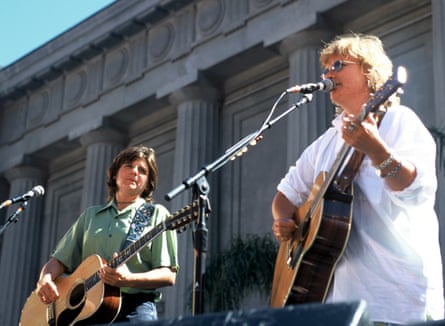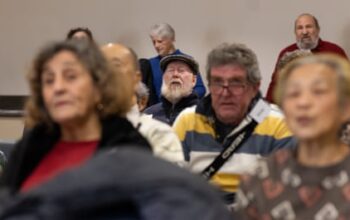In 1990, as her duo Indigo Girls were heading to platinum-selling success in the US, Amy Ray founded her own label called Daemon Records, formed as “a supportive network for each other within it, almost like a co-op,” she says. She internalised this “ecosystem idea” from Fugazi’s Ian MacKaye and the Washington DC punk scene, as well as the 90s riot grrrl movement.
But the inspiring new documentary, It’s Only Life After All, makes it clear that Ray also learned quite a bit about the power of community from Indigo Girls themselves: the folk band she co-founded in Atlanta with high-school choir buddy Emily Saliers. The duo twice broke into the US Top 10, won a Grammy, and sold millions of albums in the late 80s and early 90s, and today remain a reliable, busy touring and recording act – even earning a high-profile spot in the Barbie movie. Community is woven into every aspect of their lives and careers: the women are principled activists and queer icons who have a fiercely devoted fanbase, and take great care to nurture these relationships via their art and direct action.
“We don’t want it to be a vanity film,” Ray says of It’s Only Life After All. “We want it to be about the community, because that’s where we came from and that’s what we’re part of still. And it’s bigger than us, really.” The film duly underscores the duo’s commitment to causes such as animal and reproductive rights, and Indigenous environmental activism; it incorporates moving interviews with fans, who detail the formative moments they’ve experienced alongside the Indigo Girls’ music, such as coming out, getting married or divorced, embracing sobriety and growing up queer.
Speaking on a video call, the duo have the kind of conversational ease and respect intrinsic to a decades-long friendship: neither interrupts the other. Ray has always appreciated the Indigo Girls’ supporters and admired the “amazing things” they accomplish. “There’s teachers, peace workers, activists, doctors, librarians and people that do creative things,” she says of their audience. But hearing fans discuss the Indigo Girls’ music in the film – and bearing witness to the joy of fans sharing it with each other – was “profound” for her. “The audience is all one energy,” she says, a reverent tone in her voice. “It’s all woven together so tightly. It gave me even more respect for what it is.”
It’s Only Life After All also honours the various artists and musical communities that have supported the Indigo Girls: the Atlanta club Little Five Points, where the duo honed their skills as performers; pioneering queer musicians such as Ferron and the Butchies; folk icon Joan Baez; and fellow DIY-minded Georgia bands such as REM, who tapped the Indigo Girls to open an 1989 arena tour. “We couldn’t have made it without REM,” Ray says. “I mean, they gave us the biggest break anybody had given us.”
But even though a major label had snapped them up in 1988, the pair’s music didn’t fit neatly into any sort of box. Their acoustic instrumentation and bewitching harmonies made them a logical fit for the folk world, but the Indigo Girls didn’t shy away from amplifying their acoustic guitars with pickups, giving their sound a rougher edge.
Their smart, elegant lyrics covered the exquisite complications of life – longing, desire, beauty, darkness, anger – with philosophical dreaminess and southern gothic edge. Ray and Saliers have always written lyrics separately. In It’s Only Life After All, both confess slight embarrassment at some past songs: Saliers is incredulous about some of her more literary forays (“Who fucking writes about The Lady of Shalott?” she says, laughing) while Ray laments the solipsism of Blood and Fire.
But separately, each come to a similar conclusion about their individual songwriting strengths: using their lyrics to connect to, and empathise with, other people. A signature song, 1989’s Closer to Fine, celebrated striving for optimism even when everything else in the world felt uncertain. That type of thing riled up a cynical music press: It’s Only Life After All illustrates that Indigo Girls were ignored by mainstream magazines or criticised for their earnestness, and dogged by sexism and homophobia.

Watching today, the invasive (or at least ill-informed) lines of questioning from interviewers are shocking. Vintage footage in the documentary includes a journalist starting out with this: “Y’all have sort of the reputation now of being a ‘woman’s group’ – that if men listen to you, something horrible will happen to [them].” In another striking moment, Ray and Saliers are asked to read a particularly harsh archive New York Times review, with its first line: “Earnest pretentiousness has new standard-bearers.” Saliers replies: “Men folk singers could get away with a lot of these sentiments without being destroyed in a review like this.”
It’s Only Life After All also explores how different the musical landscape was for queer artists when the Indigo Girls first emerged. Both women had been out within their own communities before signing to a major label, but Saliers was reluctant to talk about her sexuality publicly: “When national press was reaching out about being queer, I had a lot of fear about it at first.” For starters, she didn’t want to be pigeonholed; but she was also a more private person, “protective of my personal life, because I had an uncomfortable relationship with being in the public.”
Drawing on support from Ray, she eventually came out in public on her own time and terms. “And then it was like a veil was lifted,” Saliers says. “[It] was just a wonderful freedom that occurred, and then there was really no fear from that point on.” And today Saliers celebrates how there’s “a place for queer artists that simply did not exist when we first started out. It’s good to remember that.” Still, seeing the film solidified “the reality that we had gone through some things,” she says, “that we faced pushback societally for being gay, and that we experienced sexism and homophobia and we experienced self-homophobia as a result of all the forces.”
Part of that arose from an oppressive cultural climate, where being queer was the punchline of a joke or greeted with hatred. (Saliers describes a harrowing incident of gay bashing where she was punched in the face.) But this also stems from deeply personal experiences. In the documentary, Ray details a college relationship where her partner had trouble accepting (and thus had shame around) being gay – and Ray subsequently went through a “self-loathing time”, exacerbated by the dawning realisation that not everyone approved of the relationship. “You think you’re just in love,” she says in the film, “and then you’re like, ‘Oh, wow – no, people think this is bad.’”

Director Alexandria Bombach anchors the film with new, ultra-candid interviews such as these alongside archive material (fortuitously, Ray used to tote a camera around on the road). The duo were already familiar with Bombach’s work – they were moved by her award-winning 2018 documentary On Her Shoulders, about 23-year-old Yazidi genocide survivor Nadia Murad – and “trusted her instincts and artistic abilities” as they made the film. Ray thought to herself: “What’s the point of doing this if we’re not just completely open about everything?”
after newsletter promotion
Being open came easier to Ray; she had previously publicly discussed things such as living with gender dysphoria. Saliers, however, was talking about some deeply personal things – especially her struggle with (and recovery from) alcoholism – for the first time in an in-depth way. Bombach’s “disarming” nature left her “really free to reveal to her whatever the things were that she was asking”. Over time, Saliers has also found it easier to be open. “I still consider myself a fairly private person, but there’s a balance that I’ve been able to find.”
It’s Only Life After All gets a wider online release this week, but it premiered in 2023 as Closer to Fine was having its own moment in Greta Gerwig’s Barbie, where Margot Robbie as Barbie belts out the song during a transformative car ride. Saliers notes that after the movie came out, she first checked the Indigo Girls’ listener stats on Spotify. “Of course, they exploded,” she says, and then chuckles loudly. “But then it just got back to the usual number.”
But both women say the Indigo Girls’ audiences have swelled since Barbie and It’s Only Life After All, with the renewed excitement increasing “the numbers and the energy and the enthusiasm” of their live shows, Ray says. She cites the grassroots, word-of-mouth support that’s always sustained them: “People that had followed us for a long time, when they saw this stuff happening, they used it as a moment for them to influence their peers to take back up the idea of coming out to see us play.”
This year they will play some of their biggest venues in 25 years, thanks to co-headlining tours with Melissa Etheridge and then Amos Lee. “We couldn’t play most of those places just by ourselves as a headliner,” Ray admits. “We’re still a working band in a lot of ways.”
Elsewhere, their songs propel another recent film, the jukebox musical romance Glitter & Doom, including a lovely new original tune called What We Wanna Be; Ray released a solo album in 2022 If It All Goes South via Daemon Records. Saliers is writing the music for no less than three musicals: Starstruck, co-written by Tony-nominated actor Beth Malone, plus another based on the Indigo Girls’ 2020 song Country Radio and one more on the 2018 documentary The Gospel of Eureka, about LGBTQ+ lives in small-town Arkansas.
For Saliers, It’s Only Life After All is a reminder of “an amazing balance of differences” between her and Ray: “Different sensibilities, personalities, voices, songs.” But she explains how fortunate they both feel, with It’s Only Life After All underlining “the beauty of our community – people who keep our musical reality alive. We’re getting up there in age, and I feel more a resurgence of joy about playing live concerts. It’s actually as big as it’s ever been, if not bigger.”
Source: theguardian.com


